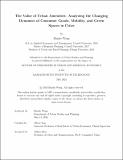| dc.description.abstract | Urban amenities, ranging from diverse consumer goods and services to pleasant environmental settings, reliable public services, and convenient mobility options, make cities appealing places to live. The evolution of these amenities has been a dynamic process influenced by technological advancements, shifts in lifestyles, and market changes. The provision of amenities constantly involves the interplay between the private and public sectors, making them important questions in city planning. This dissertation explores these critical themes through three essays, each utilizing a distinct type of amenity to demonstrate the processes, dynamics, and underlying reasons for the changing landscape of urban amenities. Essay 1 focuses on an everyday amenity—retail stores in the context of the working-from-home (WFH) transition, highlighting the interdependency of urban density and consumer amenities. I use mobile-device foot traffic data for retail establishments in 5,295 cities and towns, supplemented with online expenditure and retail rental market data, to explore the reorganization of retail activities in the U.S. Essay 2 investigates flexible mobility, an amenity enabled by ride-hailing platforms and is primarily prevalent in dense urban areas. I discuss the mobility consequences and economic implications of regulating ride-hailing services, using evidence from the ride-hailing congestion tax in Chicago. Essay 3 explores the creation of urban green spaces, a fundamental environmental amenity. I analyze the relationship between public green spaces and gated green spaces within residential complexes in Xiamen, China, and argue that in the process of rapid urbanization, local governments may delegate the responsibility of providing green spaces to private developers, leading to the prevalence of supersized gated communities in Chinese cities. | |
